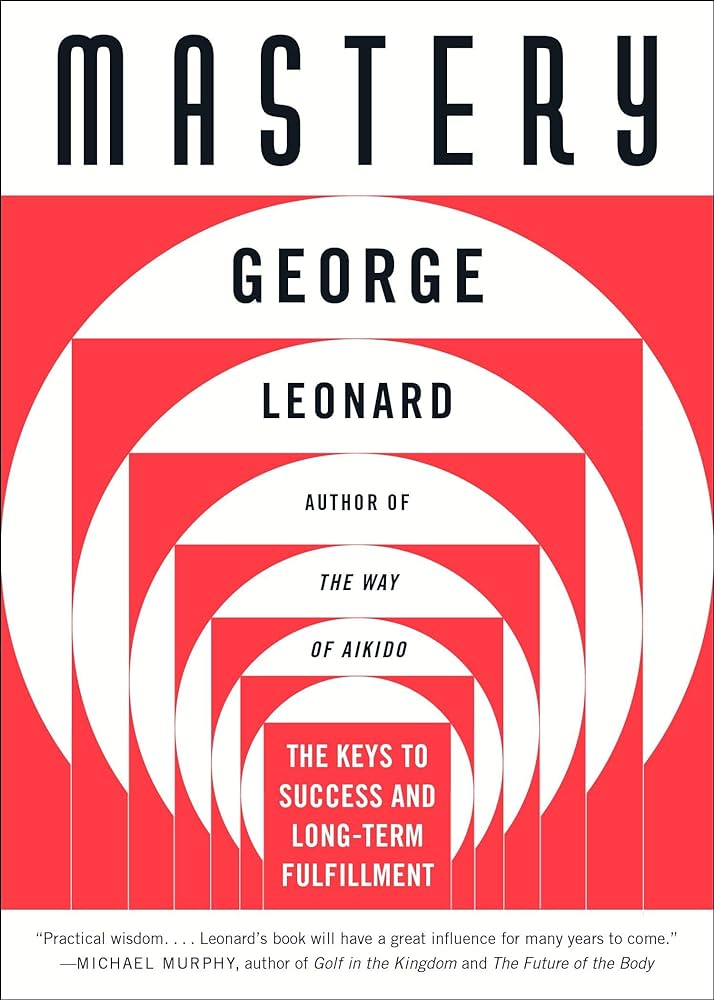In his late 40s, American writer George Leonard took up the practice of aikido (modern Japanese martial art) and he went on to earn a a fifth-degree black belt. In Mastery: The Keys to Success and Long-Term Fulfillment, Leonard draws up his expertise in aikido and Zen philosophy to describe the process of mastery. He identified the five keys to mastery as instruction, practice, surrender, intentionality and the edge.
“If there is any sure route to success and fulfillment in life, it is to be found in the long-term, essentially goalless process of mastery.”

The book is based on Leonard’s 1987 Esquire Ultimate Fitness special, MASTERY: TAKING IT HOME – Its principles can be applied to anything in life that involves learning—even love. The subject of the special was mastery “the mysterious process during which what is at first difficult becomes progressively easier and more pleasurable through practice.” The purpose of the feature was to describe the path that best led to mastery, not just in sports but in all of life, and to warn against the prevailing bottom-line mentality that puts quick, easy results ahead of long-term dedication to the journey itself.”
Mastery: Tthe mysterious process during which what is at first difficult becomes progressively easier and more pleasurable through practice.
What is Mastery?
Mastery isn’t reserved for the super talented or even for those who are fortunate enough to have gotten an early start. It’s available to anyone who is willing to get on the path and stay on it—regardless of age, sex, or previous experience. The trouble is that we have few, if any, maps to guide us on the journey or even to show us how to find the path.
The modern world, in fact, can be viewed as a prodigious conspiracy against mastery. We’re continually bombarded with promises of immediate gratification, instant success, and fast, temporary relief, all of which lead in exactly the wrong direction.
The Mastery Curve
There’s really no way around it. Learning any new skill involves relatively brief spurts of progress, each of which is followed by a slight decline to a plateau somewhat higher in most cases than that which preceded it.
In the actual learning experience, progress is less regular; the upward spurts vary; the plateaus have their own dips and rises along the way. But the general progression is almost always the same. To take the master’s journey, you have to practice diligently, striving to hone your skills, to attain new levels of competence. But while doing so—and this is the inexorable fact of the journey—you also have to be willing to spend most of your time on a plateau, to keep practicing even when you seem to be getting nowhere.
Type of Learners
We all aspire to mastery, but the path is always long and sometimes rocky, and it promises no quick and easy payoffs. So we look for other paths, each of which attracts a certain type of person.
The Dabbler, the Obsessive, and the Hacker
The Dabbler
The Dabbler approaches each new sport, career opportunity, or relationship with enormous enthusiasm. He or she loves the rituals involved in getting started, the spiffy equipment, the lingo, and the shine of newness. When he makes his first spurt of progress in a new sport, for example, the Dabbler is overjoyed. He demonstrates his form to family, friends, and people he meets on the street. He can’t wait for the next lesson.
The Obsessive
The Obsessive is a bottom-line type of person, not one to settle for second best. He or she knows results are what count, and it doesn’t matter how you get them, just so you get them fast. In fact, he wants to get the stroke just right during the very first lesson. He stays after class talking to the instructor. He asks what books and tapes he can buy to help him make progress faster.
The Hacker
The Hacker has a different attitude. After sort of getting the hang of a thing, he or she is willing to stay on the plateau indefinitely. He doesn’t mind skipping stages essential to the development of mastery if he can just go out and hack around with fellow hackers. He’s the physician or teacher who doesn’t bother going to professional meetings, the tennis player who develops a solid forehand and figures he can make do with a ragged backhand
Practice as a verb vs Noun
You practice in order to learn a skill, in order to improve yourself, in order to get ahead, achieve goals, make money. This way of thinking about practice is useful in our society; you obviously have to practice to get to Carnegie Hall.
For one who is on the master’s journey, however, the word is best conceived of as a noun, not as something you do, but as something you have, something you are. In this sense, the word is akin to the Chinese word tao and the Japanese word do, both of which mean, literally, road or path. Practice is the path upon which you travel, just that.
Devotion to a goalless Journey
Devotion to the goalless journey might seem incomprehensible if not bizarre. But behind the slogans you read on the sports page and in the business section there’s a deeper reality: the master goes along with the rhetoric about scoring and winning (in today’s media climate, who would listen to anything else?), but secretly cherishes those games filled with delicious twists and turns of fortune, great plays, close calls, and magical finishes—regardless of who wins.
The Paradox of Success
Almost without exception, those we know as masters are dedicated to the fundamentals of their calling. They are zealots of practice, connoisseurs of the small, incremental step. At the same time—and here’s the paradox—these people, these masters, are precisely the ones who are likely to challenge previous limits, to take risks for the sake of higher performance, and even to become obsessive at times in that pursuit. Clearly, for them the key is not either/or, it’s both/and.
Obsessive goal orientation
The desire of most people today for quick, sure, and highly visible results is perhaps the deadliest enemy of mastery. It’s fine to have ambitious goals, but the best way of reaching them is to cultivate modest expectations at every step along the way. When you’re climbing a mountain, in other words, be aware that the peak is ahead, but don’t keep looking up at it. Keep your eyes on the path. And when you reach the top of the mountain, as the Zen saying goes, keep on climbing.



Comments are closed.